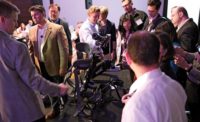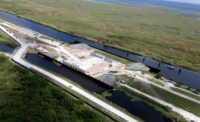Designers and contractors demonstrated how they’ve taken digital twins from conceptual buzzword to real-world applications at Bentley Systems’ Year in Infrastructure conference, held in Singapore Oct. 21-24. While the software and cloud services firm did announce several strategic acquisitions and developments, most of the focus was placed on helping the hundreds of software users in attendance to delve deep into the myriad uses of digital twins along the entire lifecycle of their projects, from design to construction to operations.
“It’s an amazing experience to see all the software and what you can actually do on your projects using them,” says Bayan O. Abdel Rahman, 4D planning specialist with Dubai-based contractor ALEC.
In one key announcement at YII, Bentley and Topcon Positioning Systems publicly took the wraps off a 50-50 joint venture consulting business called Digital Construction Works. DCW will help customers implement digital transformation solutions like advanced work packaging, 4D innovations in surveying, reality modeling, and other advanced tools. The new business will work toward “closing the advancement gap,” says Bentley Systems CEO Greg Bentley. It is the culmination of a five-year alliance between the firms.
Topcon President and CEO Ray O’Connor traced the venture’s roots to academies held in 2016 that brought engineers and contractors together. “What we learned was that engineers are not necessarily discussing with contractors how they do their work. How do you automate the entire workflow if you don't understand how the people you're sending designs to do the work?”
Both Bentley and Topcon have invested human capital as well as money in the integration business. Among the staff of 50 at DCW, Ted Lamboo, the new CEO, was formerly Bentley’s senior vice president of strategic partnerships, and Jason Hallett, the new COO, was a Topcon vice president involved in global business development and digital construction initiatives. DCW is also tapping construction industry domain experts such as Marvin Johnson, a digital twins specialist formerly with Bechtel Corp.
Significantly, Lamboo said DCW will be “agnostic” when recommending technology tools to customers. It will work with customers’ legacy systems and integrate whatever additional tools are required to achieve the customer’s goals—tools from Bentley, Topcon or any other vendor. Customers with DCW work already under way include advanced work package implementations for Shell and consulting for Balfour Beatty. “Implementing full digital construction solutions into our business such as those provided by DCW, will enable us to achieve our project outcomes and business goals,” said Harry Parnell, head of digital project delivery for Balfour Beatty.
Lamboo said DCW will be talking to customers about “outcomes-based business models,” particularly on advanced work package implementations, where DCW’s earnings are a percentage of the savings its work generates for the project. An alliance announced with O3 Solutions Inc. helps make that possible. CEO Josh Girvin said O3’s process measurement software measures outcomes and tells users how close or far they are from the project’s goals.
Real-World Project Application
A major component of the conference revolves around the Year in Infrastructure awards, where 571 entries competed in 18 categories. Three finalists were selected by the judges in each category and presented their digitization accomplishments to conference attendees and judges and showed off the challenges that can be solved by implementing Bentley’s software and digital twin services.
For example, at the 18,000-seat Chase Center Warriors Arena in San Francisco, the Mortenson Clark joint venture met an immoveable deadline for the opening game of the basketball team recently despite site constraints from helicopter flight paths, an adjacent hospital and nine neighboring construction sites. An intensive application of Synchro 4D Construction Modeling tools coordinated the movements of five tower cranes, two crawler cranes, 36,700 scheduled tasks and 93,000 scheduled relationships. Michal D. Wojtak, integrated construction director for sports and entertainment at Mortenson, said the $1.4-billion arena put in place “560% more volume of work in the same time frame” than the Sprint Center Arena, the first Mortenson sports project where 4D modeling was used. He said, “4D Synchro Modeling was a critical solution for us.”
In another example, a team created a high resolution digital model of the Saudi Arabian city of Medina, one of two great holy cities of the Muslim world. Five companies responded to the city’s request for proposals for high resolution mapping. Four proposed conventional surveys, and one proposed using a hybrid mix of drone and mobile Lidar mapping technologies, according to Khalid F. Sallam, manager of the geomatics unit at AHCEC Engineering, based in Al Khobar, 600 miles to the east.
AHCEC offered to use drones to accomplish the project in about half the expected time for about half the cost. Intrigued, the city authorities asked for a demonstration, and in 10 days they delivered a 5-sq-km sample of what they proposed to do.
“When we showed the model, they said yes on the spot,” Sallam says. That led to a negotiated contract in Dec. 2018, and ACEC’s next challenge, which was to scale up to 50 km and deliver LOD 3 mapping for the entire city, with its 7,104 km of streets, as well as a LOD 4 reality model for The Prophet’s mosque — in one year.
Sallam says the amount of data and processing required was enormous. The company tested four aerial imagery processing services before settling on Bentley’s Context Capture, which was the only one of the ones tested that would allow simultaneous, parallel processing of the same model. It selected off-the-shelf DGI Phantom 4 drones, whose cameras have mechanical, rather than digital shutters to eliminate motion blur.
AHCEC trained five local pilots, but automated the flying using Drone Deploy to eliminate variations in the human pilots’ flying styles. It broke the project up into 7,306 cells, or missions. Each flight automatically ticked off a cell in the project plan as it was completed, and Sallam monitored the progress from his office in Khobar where a 200 Tb NAS filer collected the processed data.
The company also used ground-based, vehicle-mounted data acquisition tools and Orbit GT, a mobile mapping system recently acquired by Bentley, to process and drape still, 360 degree and panoramic imagery on LiDar data, to fill in the blanks in the ancient parts of town where the narrow streets and roof overhangs interfered with drone data acquisition.
The deliverable, by the end of the year, includes a trained set of pilots and technicians with the skills to maintain the model, as well as that big server holding the data. The city planners expect to use the model to help them plan for expanded capacity to accommodate the pilgrims who come to Medina up to 30 million people by 2030, from 8 million who came in 2015, and to increase the capacity of the Prophet’s mosque to 4 million worshipers annually, from the 1 million who came to pray in 2012.
Digital cities has become a “new area of focus” for Bentley Systems, says Greg Bentley. In addition to the acquisition of Orbit GT, Bentley announced the purchase of Citilabs, which provides predictive transportation software that simulates mobility.
But to solve real-world problems with a digital twin of a city, planners must start with a problem to solve and look at it from the citizen’s perspective, says Ayesha Khanna, CEO and co-founder of ADDO AI, in her keynote address. “Too long have smart cities been defined by how high tech they are. We have to stop that now. The kind of smart city that you want is one that is taking care of the needs of its citizens every single day.”
Looking Through the HoloLens
At the conference, a limited number of units of the Microsoft HoloLens 2 augmented reality headsets were on display and available for individual demonstrations. The second iteration of the HoloLens shown were running features co-developed in an special partnership with Bentley Systems that make it readily apparent how far the system has advanced toward practical applications.
The wireless units displayed are built into a comfortable head strap similar to the lining of a hard hat, with a knob on the back to adjust fit. The peripheral vision range has been expanded and the translucent lens can fold up for unobstructed vision, although it barely interferes with normal vision when down and superimposed with information and images.
As soon as a new user places the unit on their head it takes a retinal scan in the background before going through a series of visual and finger pointing exercises to customize the graphics that will be displayed, adjusted for the wearer’s individual visual needs. Each unit can be used by many people, but each time a former user puts it on again it will read their retina and automatically match the calibration to their eyes as before.
The features demonstrated that were developed with the help of the Bentley team included one to let multiple users collaboratively examine a 3D building model, which is called into visual existence by glancing at a QR code. The multi-story model could be constructed or deconstructed with the help of a finger-tip adjustable timeline slider floating in air to the right. It also included a sectioning tool for slicing the model along the X, Y, or XYZ axis that was so intuitive to use no instruction was required. Flags can be dropped onto it to indicate areas of interest for discussions of risk or other issues.
A virtual touch of another button floating in air brought the model up to full scale, allowing the wearer to walk around inside it and use features such as calling up metadata on equipment, ticking off check lists and capturing notes about objects using speech to text recognition.
Only a handful of the HoloLens 2 units are in circulation, and Bentley and Microsoft had six pre-production units on display; but Microsoft is said to be close to going into production to deliver a first order batch for the U.S. Dept. of Defense. Bentley's SYNCHRO 4D has been working with the HoloLens since 2016 and officially joined Microsoft's Mixed Reality Partner Program in 2018.







Post a comment to this article
Report Abusive Comment